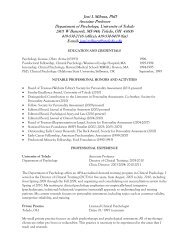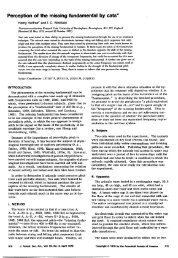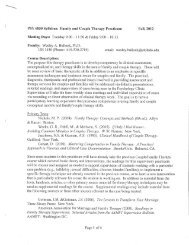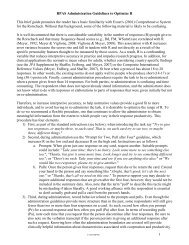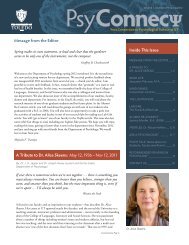The Rorschach Rating Scale: Item Adequacy, Scale ... - Psychology
The Rorschach Rating Scale: Item Adequacy, Scale ... - Psychology
The Rorschach Rating Scale: Item Adequacy, Scale ... - Psychology
- No tags were found...
Create successful ePaper yourself
Turn your PDF publications into a flip-book with our unique Google optimized e-Paper software.
208 MEYER, BATES, GACONOria, resulted in factors that did not meet the retention criteria Guadagnoli andVelicer (1988) recommended. Although we do not believe our altered guidelinesfor parallel analysis should be adopted by researchers in general, given the complexfactor patterns in our data matrices, adopting this more stringent standardfor defining the number of factors allowed us to use a fixed criterion that preventedthe extraction of poorly defined factors. This modified criterion also ensuredthat factors extracted from the RRS would be at approximately the samedegree of generality as those of the B5M. In other words, given that the modifiedcriteria indicated five factors should be extracted from the 50 B5M items,employing the same criteria across all analyses ensured we did not comparemore narrowly defined RRS factors to the broader, more comprehensive factorsderived from the B5M.RRS <strong>Item</strong> AnalysesTo determine whether the RRS contained any obviously poor items that did not discriminateamong people (i.e., items that were either highly or minimally characteristicof all people), we evaluated the range and standard deviation for each item.Using a priori criteria, an item was considered poor if any of the following weretrue: (a) the range was less than 4.0, (b) the median was less than 2.0 or greater than4.0, or (c) the standard deviation was less than .75. No items met any of these criteria.Each item had a range of 4.0 and a SD > .91.Although we did not develop criteria for rejecting items based on skew, onlytwo items had skewness greater than |1.0|. <strong>Item</strong> 9, which had a skew value of 1.075,asks about the propensity to identify with superhuman characters or characters ofmythic proportions. <strong>Item</strong> 160, which had a skew of 1.149, asks about experiencingpleasure in the suffering of others. Because both items assess highly unusual characteristics,we were not surprised that their distributions were somewhat skewed.(B5M items had no variables with skewness > |.85|.)<strong>Item</strong>s were also examined for redundancy. A priori we decided to scrutinizeitem pairs with a correlation greater than .79. <strong>The</strong> 176 RRS items produced 15,400correlations. <strong>The</strong> highest correlation (.83) was obtained between items 87 and 88,which assess misperceptions due to anger and misperceptions due to any strong affect,respectively. Although conceptually similar, we believed the distinction betweenthese items and the size of their correlation did not warrant deleting one ofthe pair. Seven other item pairs had correlations between .70 and .74. <strong>The</strong>se itempairs were next to each other in the rating scale and addressed conceptually similarbut not synonymous constructs (i.e., 5 & 6, 28 & 29, 88 & 89, 93 & 94, 132 & 133,142 & 143, and 179 & 180). None of these pairs was considered sufficiently redundantto warrant deleting an item.Copyright © 2000 All Rights Reserved



